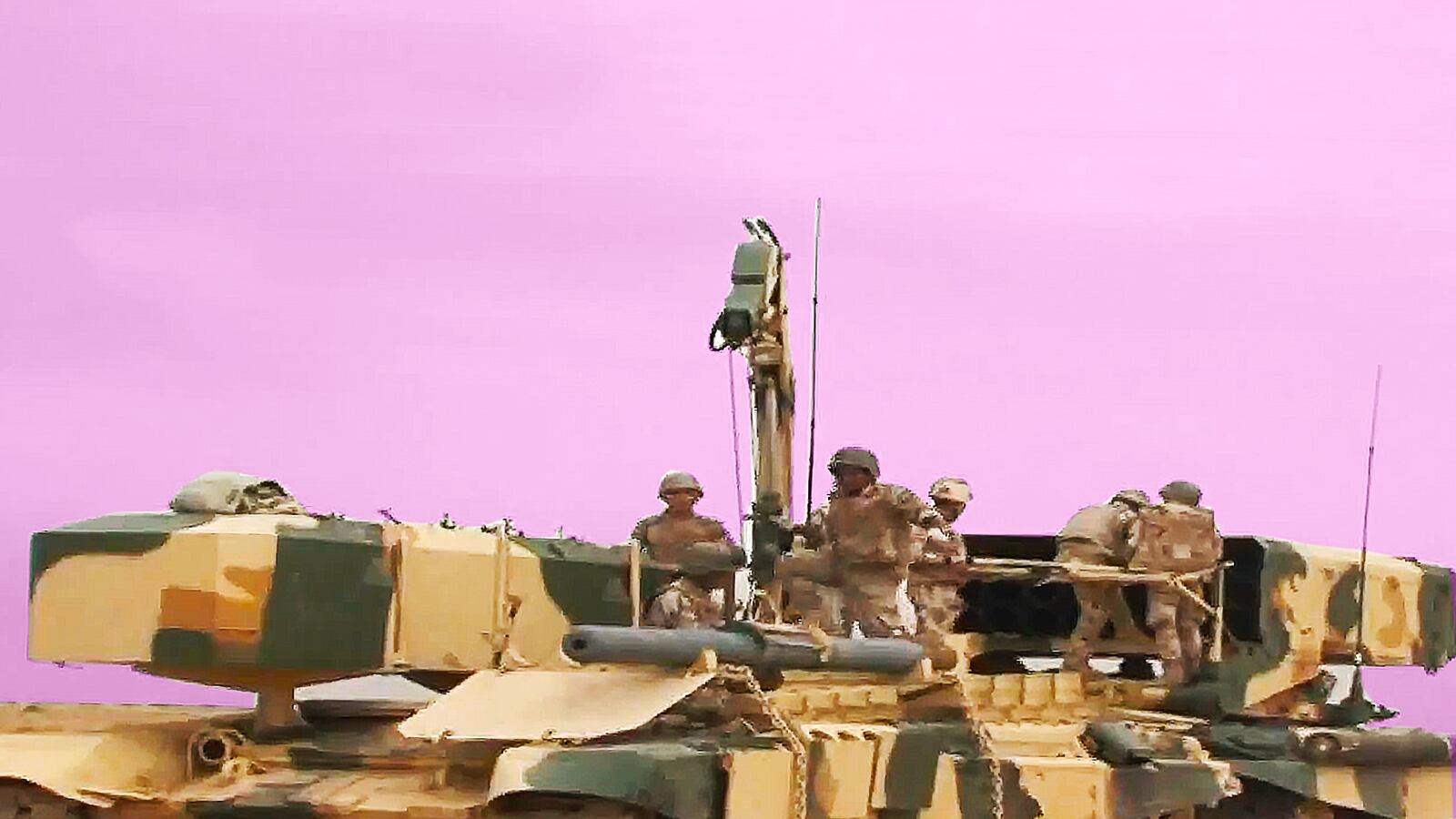The coalition assault on Mosul has steadily chipped away at ISIS’s last and biggest major stronghold in Iraq. A reported 100,000 Iraqi, Kurdish, and coalition troops—including American commandos, air-controllers, and artillerymen—have attacked from south and east, respectively, aiming to dislodge an estimated 10,000 ISIS fighters in the northern city of 1.5 million people.
The stakes couldn’t be higher—and both sides know it. ISIS and the U.S.-led coalition have both deployed their latest, best and—in a few cases—most desperate weaponry. From city-block-smashing rocket-tanks to DIY killer robots, these are the defining weapons of the battle for Mosul.
Soviet-Era Rocket-Tanks
In 1988, the Soviet army introduced a fearsome new weapon—the TOS-1 rocket-tank. Built on the chassis of a T-72 main battle tank, the TOS-1 boasts a 24-pack of roughly 9-inch-diameter rockets in place of the tank’s turret. Each of those rockets lugs 220 pounds of explosives and can hit targets from up to 3 miles away. Ripple-firing all 24 rockets could blanket an area the size of two city blocks in munitions.
And not just any munitions. The TOS-1’s rockets are thermobaric weapons. Where traditional warheads count on instantaneous explosive force for their destructive power, thermobaric weapons are slower and more insidious in nature—and potentially much more destructive, pound for pound. The TOS-1’s rockets spread a cloud of flammable gas then ignite the cloud, burning up all the oxygen for hundreds of feet in all directions and producing a devastating blast effect.
The Soviets developed the TOS-1 as a way of flattening dense urban defenses in order to clear paths for attacking tanks. Needless to say, the TOS-1’s rockets pose at least as much danger to civilians as they do to dug-in combatants.
Moscow provided at least four TOS-1s to Baghdad’s army back in the summer of 2014. This month, The Jerusalem Post’s Seth Frantzman spotted one of the fearsome vehicles in Bartella, a town just 10 miles from Mosul that Iraqi forces had just liberated from ISIS.
The TOS-1’s arrival at the front line is a string indication that Baghdad’s plan for the final assault on Mosul involves a brutal, fiery bombardment.
Mad Max Suicide Trucks
ISIS is outnumbered and outgunned in Mosul but that doesn’t mean the group’s fighters are unprepared. The militants have held the city for two years—long enough to dig in and plan their defense.
That plan clearly leans heavily on counterattacks by suicide-bombers—in particular, suicide-bombers driving tricked-out, armored, explosives-laden trucks that look like something out of Mad Max. The trucks began rolling out to blast Iraqi and Kurdish forces just days after the Mosul offensive began.
The U.S. military calls these bomb-and-truck combos “vehicle-borne improvised explosive devices,” or VBIEDs. They were among the deadliest weapons Iraqi insurgents used against occupying U.S. troops before ISIS’s formation.
Painfully aware of the truck-bombers’ destructive potential, U.S. planners began systematically striking ISIS’s VBIED factories in and around Mosul from the air as early as 2015. And when the first truck-bombs trundled out of Mosul this month, coalition warplanes were waiting for them. One video from Kurdish news outlet Kurdistan24 claims to depict an American plane bombing an ISIS VBIED northeast of Mosul on Oct. 24.
DIY Killer Drones
ISIS might not have access to big, high-tech, missile-armed drones like the United States and its allies routinely deploy (and yes, that includes Iraq). But that doesn’t mean the militant group hasn’t joined in the drone craze in a big, bloody way.
The terrorists have bought inexpensive, quad-copter-style drones and sent them aloft to spy on coalition forces and record video of attacks and other atrocities for propaganda purposes. Perhaps taking their lead from Hezbollah—which in August released a video depicting one of its own copter-drones dropping grenade-size munitions on rebel fighters in Syria—the militants have also begun strapping small explosives to some of their drones and flying them kamikaze-style into coalition positions.
This new tactic became painfully apparent in early October when Kurdish forces in northern Iraq shot down what they believed was an unarmed ISIS spy drone. The Kurds hauled the wreckage back to their base. As they were inspecting the crippled robot, it exploded, killing two people.
Drone Zappers
The Pentagon reacted swiftly to the suicide-drone threat. While the defense industry works on long-term solutions—the Marines, for one, have asked for a truck armed with a drone-zapping laser—this summer military officials desperately sought a quick fix, perhaps mindful of the impending Mosul operation.
The U.S. brass tapped the Joint Improvised Explosive Device Defeat Organization—a controversial agency with its roots in the American occupation of Iraq—to lead the effort. Meanwhile, the Air Force stood up its own counter-drone program. The Defense Department asked Congress for an emergency, $20-million appropriation to help pay for the initiatives.
The crash anti-drone programs scored their first success in early October when, according to Air Force Magazine, two U.S. spy planes deployed unspecified “electronic warfare capabilities” to knock an ISIS drone out of the sky over Mosul. The electronic capabilities in question are almost certainly airborne radio-jammers that can interfere with the signals that ground-based operators use to control their drones.
More than a decade ago, the Joint Improvised Explosive Device Defeat Organization helped to develop truck- and backpack-mounted radio jammers for ground forces. The Air Force, Navy, and Marine Corps have long operated much more powerful jammers aboard aircraft, typically deploying them to prevent insurgents from remotely detonating bombs. It’s a small shift to aim those aerial jammers at drones, instead.
But there’s a catch. Electronic jamming is fairly indiscriminate. So if you’re blocking a drone’s command signal, you’re probably also blocking radio and cellular communications—including those of your own forces—across a wide area. Making calls during the battle of Mosul might not be that easy.






